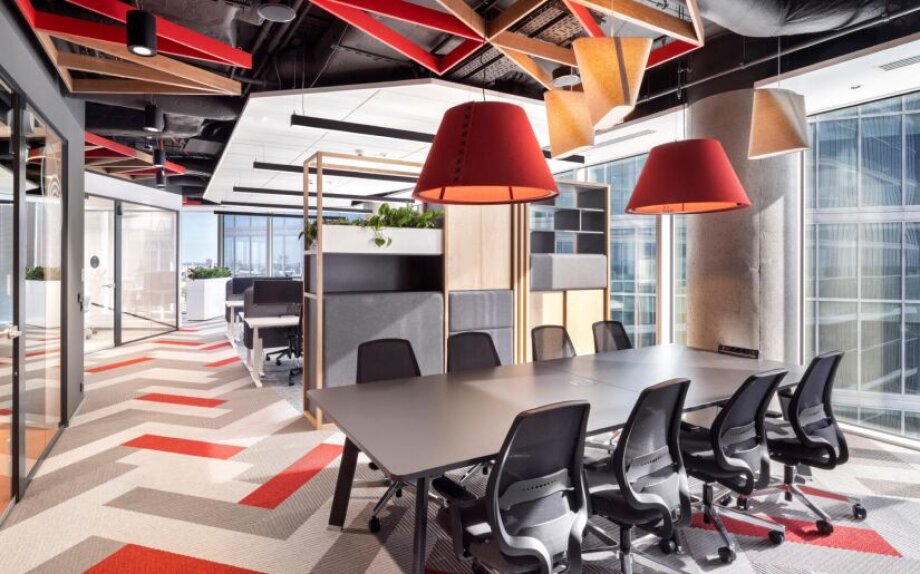In the first quarter of 2021, the total office stock in Warsaw and the eight largest regional markets accounted for over 11.9 million sqm. The vacancy rate has continued its upward trend since the second quarter of 2020, largely driven by economic uncertainty caused by the outbreak of the Covid-19 pandemic. Amid subdued occupier activity in recent quarters and a build-up of new supply in the last twelve months, the vacancy rate rose to 12.2 percent, up by 3.8 pp year-on-year. Occupier activity has also continued a downward trend since the onset of the pandemic with total leasing activity accounted 213,500 sqm in the first quarter of 2021, reflecting a drop by 41 percent in comparison to the same period in 2020.
Dependent development
The future development direction of the office market will largely depend on how the pandemic unfolds and on the rollout of vaccinations. We are currently at a point where several countries are beginning to gradually return to normal thanks to massive vaccination programs. With high vaccination rates, countries such as the US, the UK, and Israel are now gradually reopening their economies while many companies are opting for a phased return to office work.
Looking ahead, this year’s office transactions volume is expected to be on a par with that of 2020. 2021 will also be a year of market recovery and recommencement of processes pushed back from last year. On the other side, office supply will probably take longer to respond to the outbreak of the pandemic as projects under construction continued and the development pipeline scheduled for 2021-2022 will, in large part, come to fruition as planned. In the next two years, we are likely to see a delayed response on the supply side with fewer new projects being delivered to the market in 2023-2024. Additionally, office availability and vacancy rates are expected to continue their upward trends over the next 12 months, resulting from weaker leasing activity and the growing availability of office space in older buildings.
The change of preferences
The Covid-19 pandemic and economic uncertainty have caused most tenants in 2020 to decide on a wait-and-see strategy regarding their occupational needs which was visible in the limited demand for office space in recent quarters. This situation has also caused a change of approach by investors because an increased share of remote work resulting from the pandemic also affected the parameters of a lease, negotiation processes, and content of lease agreements in both new and renegotiated transactions.
Tenants who cannot predict the development of the situation and cannot estimate the potential impact of the pandemic on the scale of their business are looking for flexibility and ways to reduce current costs related to the leasing of office space. Moreover, some tenants still haven’t decided what form of work will be implemented in their offices after the end of the pandemic.
Therefore, optimizing costs and flexibility has become a crucial trend for tenants today. This can be achieved by negotiating extended rent-free periods. In order to obtain a sufficiently long period of “rental vacation,” tenants are ready to accept higher headline rents after the incentives are in force or to decide for a longer lease period. Such transactions with appropriately selected financial parameters may be a solution that meets the needs of the tenant and are beneficial for the landlord.
On the other hand, a significant amount of negotiations was put on hold due to uncertainty and a lack of a stable business outlook. Return to negotiations was often conditioned by ensuring adequate contractual flexibility in terms of contract length and space occupied. Options such as the right of early termination of the lease agreement or the reduction of the part of occupied space have become important elements of the negotiations. Additionally, in our opinion, tenants who expect a quick return to a stable business model may focus on the option of extending their lease agreements and secure expansion or rights of first right of refusals.
Tenants are also looking for solutions that allow them to manage a current or future temporary demand for additional space. We observe that projects that can offer flex services are capturing tenant’s interest. This trend is also visible on the landlord’s side. In recent months we could observe several investors who decided to open their flex services brands such as Cavatina (Quickwork), Immofinanz (MyCowork and MyOffice), Warimpex (Mogilska43 Cowork), and Buma (AtOffice).
Paulina Misiak, partner, head of Warsaw office agency
With vaccination underway, we can see light at the end of the pandemic tunnel, but it will be months before we get there. Until the situation stabilizes, the dominant need of market participants will be to minimize cost exposure and secure flexibility, enabling them to respond quickly to changes as they happen and to adapt operations to new strategies. Due to a prolonged need for working remotely, interim solutions are turning into long-term arrangements in many organizations resulting in the pandemic preference shift towards lease renewals and space reductions. Covid-19 accelerated earlier trends toward mobility and increased the scale of remote work. At the same time, the future hybrid work model, which is very likely to be the way forward, may result in the transformation of offices into less dense and more comfortable areas guaranteeing a safe distance and favorable conditions for team interactions. The possible future trend toward increasing occupancy comfort and space ratio per desk is likely to offset current space reductions and weaker demand. There is, however, a potential forward-looking scenario and it will take some time before the market stabilizes and we can establish a confident prediction.
Soren Rodian Olsen, partner, head of capital markets
The uncertainty related to future demand and occupation of office space has slowed down investment activity in the office sector, and most institutional investors have adopted strategies focusing on other sectors such as Logistics and PRS/Multifamily. While we anticipate capital markets to return to almost) pre-Covid transaction levels in the latter part of 2021, the office leasing market and occupier demand are likely to take longer to recover. That said, core and core-plus investors continue to have an investment agenda in Poland that includes offices, albeit with a selective focus on centrally-located assets that are sub-€100m and leased up to strong-covenant tenants. At present and looking ahead, there is limited availability of office buildings that fulfill such criteria which means we anticipate further yield compression for prime, best-in-class offices.
KEY TRENDS IN 2021
Based on current the market situation, our surveys conducted during the pandemic, and feedback from market participants, the following major trends are likely to be expected in upcoming months:
• Flexibility: no matter how the pandemic unfolds flexibility will be the key factor in office leasing decisions for most tenants. This trend will result in stronger pressure on shorter lease terms, office downsizing, or allocation of financial incentives. Against the backdrop of weaker demand for office space, projects, where landlords can adopt a flexible approach.
• Flex spaces: flex spaces can be a “safe haven” for companies looking to cut office occupancy costs as they offer increased flexibility. Serviced offices are also likely to attract strong interest from corporate clients reporting increased short-term space requirements.
• Hybrid model: 100 percent remote working will be rare in the new reality as hybrid models combining work in a typical office space with flexible space and remote work in varied proportions will become more and more popular post-pandemic.
• Subleasing: being under pressure to cut costs, tenants have more frequently been offered office space for sublease during the past 12 months. Despite the growing marketing of such space, demand for sub-leasing space is relatively low amidst strong competition from flexible offices. The next few months will see fewer new sublease listings, with those failing to find subtenants being taken off the market altogether.




















